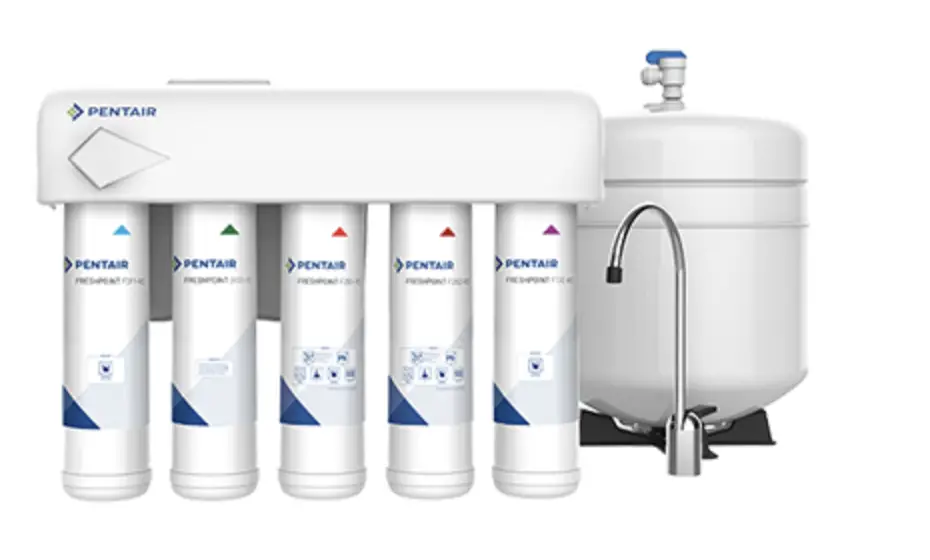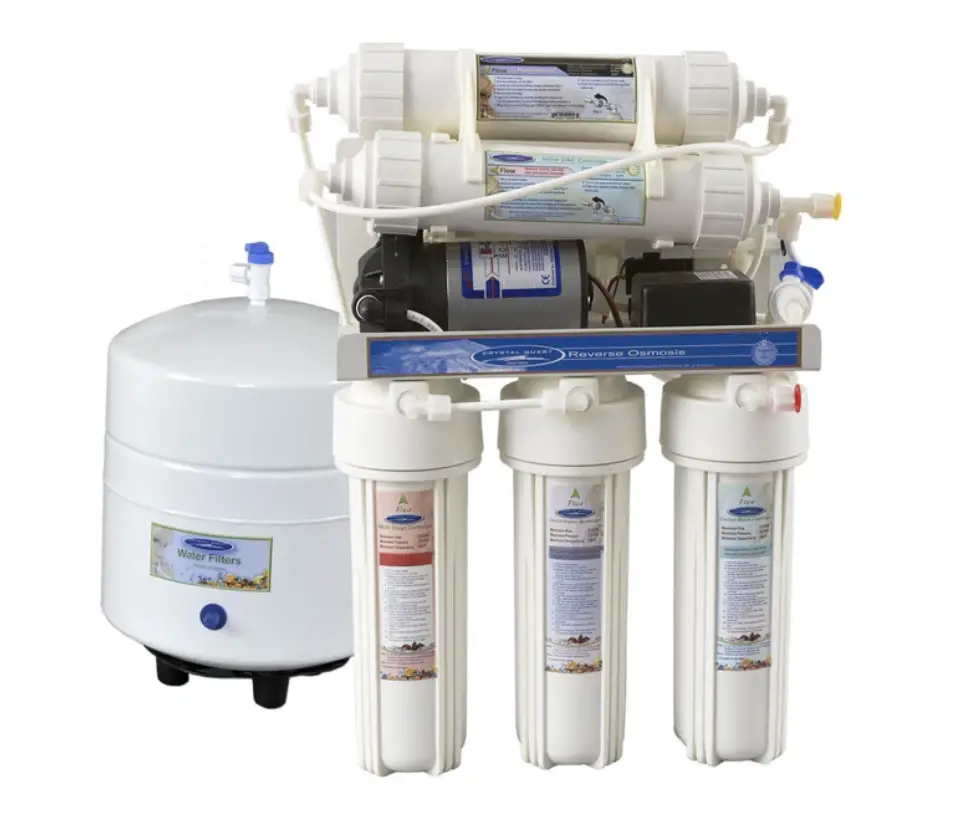More than 2 million people across the United States are exposed to high levels of arsenic in their drinking water. Reverse Osmosis systems are an effective method of water purification, but can’t remove all types of arsenic.
Reverse osmosis systems can remove more than 80% of the arsenic in water. The semipermeable membrane with tiny holes allows water to pass through, while trapping the larger arsenic molecules. Reverse osmosis can remove pentavalent arsenic (‘arsenate’) effectively, but a pretreatment is needed to remove trivalent arsenic (‘arsenite’).
This article will take you through the different types of arsenic, which ones are more likely to be in your water, and how a reverse osmosis system can remove some arsenic, but not all.
Arsenic In Our Water
Arsenic (As) is a white to grey, brittle solid that is found naturally in water and soil. Unfortunately, it’s extremely toxic when in large concentrations, especially in water.
Some agricultural and industrial sources can also discharge it into the environment.
Copper smelting, mining, and coal combustion all produce arsenic as a by-product. Arsenic can also be combined with other elements to create compounds are used to preserve wood and kill insects in cotton and other agricultural crops.
But did you know there are 4 types of arsenic? These two are the toxic ones found in our water:
- Trivalent (arsenite)
- Pentavalent (arsenate).
Trivalent arsenic is considered more toxic than pentavalent arsenic.
The type of arsenic matters, because certain types of water purification can only remove one type of arsenic, and this includes reverse osmosis.
Types of arsenic compounds
Arsenic compounds come in two major divisions. They include:
- Inorganic arsenic
Inorganic arsenic compounds are ones that aren’t attached to carbon. Arsenate (pentavalent) and arsenite (trivalent) are the most common toxic inorganic forms.
These chemicals are extremely dangerous, and a good example is Arsenic trioxide. The chemicals can be found in industries, building items, and water that has been contaminated. Inorganic arsenic, which is bonded to oxygen atoms, can be found in groundwater.
- Organic arsenic
Organic arsenic is a type of arsenic that has been mixed with carbon and other components. These arsenic compounds are far less hazardous than inorganic arsenic compounds. Some foods, including fish and different kinds of marine life can contain these compounds, because they feed on algae that contain arsenic compounds.
In terms of water purification, and harmful chemicals, organic arsenic isn’t something you need to be worried about.
How reverse osmosis removes arsenic from water
Reverse osmosis uses pressure to force water through a series of filters. A system can have between three and six filters, but most come with a pre-filter, carbon filter and a reverse osmosis membrane. It’s the membrane that makes a system capable of ‘reverse osmosis’, and is specifically sized to allow water molecules to pass through, while trapping bigger contaminants like arsenic.
The membrane is made up of thousands of tiny pores of roughly 0.0001 microns in diameter, which are too small for arsenic to fit through (Arsenic is usually 5 microns in diameter, so much bigger).
Most reverse osmosis systems can remove 80 to 99 % of the arsenic in water – making reverse osmosis one of the best water treatment solutions for removing arsenic. How much is removed will vary slightly between different systems.
Reverse osmosis units are extremely capable of removing Arsenate (pentavalent arsenic). However, other forms, including Arsenite (trivalent arsenic), need a pre-treatment to convert to the more easily remove pentavalent form. Once converted, reverse osmosis can effectively filter it out.
Potassium permanganate, ferric chloride, and chlorine are most effective at converting arensite (trivalent arsenic) to arsenate (pentavalent arsenic).
Some reverse osmosis systems come with arsenic-specific filters. These contain a resin that is just for this purpose, and often uses chlorine or potassium permanganate to help with the conversion. The membrane can then easily remove the arsenic from your water.
Reverse Osmosis Systems That Remove Arsenic
All reverse osmosis systems can remove arsenic to some extent, as long as it has a semi-permeable membrane as one of its filters, like this one from Pentair:

The Freshpoint 5 has five filtration stages and can reduce the amount of arsenate (pentavalent arsenic) to less than 5 parts per billion (ppb).
For perspective, the acceptable level in water from the EPA is less than 10 ppb. So, this system can easily lower the arsenic in your water to safe levels.
But a system that also has a pre-treatment or arsenic-specific filter to convert arsenite to arsenate will be able to remove far more arsenic from your water. For example:

The 1000CP Reverse Osmosis System from Crystal Quest has 12 filtration stages and you can add on their Arsenic Filter.
It’s made with a special resin to remove more arsenic than a standard system.
If you aren’t sure which type of reverse osmosis system to get, you can test your water (arsenic has no smell, color, or taste, we can’t detect it ourselves).
Testing Your Water For Arsenic
An arsenic-specific lab test will tell you not only how much arsenic is in your water, but whether you have more of the trivalent or pentavalent type. That way you can know if you a standard reverse osmosis system is enough or if you need one with a pre-treatment or arsenic filter.
We recommend MyTapScore as they have a good quality Arsenic Speciation home water testing kit. It’s slightly expensive but it covers you for both arsenic types (trivalent and pentavalent). While many other lab test kits don’t.
- Samples are tested in a certified laboratory and you’ll get the results in about 5 days.
For more information head to https://mytapscore.com/products/arsenic-speciation-water-test.
Why Drinking Arsenic Is Bad For Us
It’s no surprise that arsenic is bad for our health. While we think more about our water being contaminated, we are also exposed daily to arsenic in the air we breathe and the food we eat.
Some man-made products can also expose us to arsenic.
But most human arsenic exposures are from drinking water, and especially well water. In fact, more than 2 million of Americans are exposed to high levels of arsenic in their well water every day.
You can see in the image below how many of us are exposed to high levels of arsenic in our water, thanks to the USGS. The level of 10 ug/L is the same as 10 ppb, and is considered the safe limit for arsenic in our water.

But whether it’s in our water in a small or large amount, it has negative short and long term effects on our health.
As a result, the EPA established a lower arsenic in drinking water standard that applies to both community and non-transient, non-community water systems. The new 10 parts per billion (ppb) arsenic standard replaced the previous 50 ppb standard, which protects us more against the effects of long-term, chronic arsenic exposure.
Normally, the health effects of arsenic exposure depends on a few factors. These factors are:
- The type of arsenic you are exposed to. Is it organic or inorganic? (inorganic is much worse)
- The amount of arsenic you have been exposed to (higher amounts is worse)
- The period of time you have been exposed to arsenic (longer exposure is worse)
- Your age bracket
Exposure to arsenic in water has the following effects on the human body:
- Skin disorders and skin problems, such as lesions, discoloration, and the development of corns.
- High blood pressure.
- Cancers of the bladder, kidney, lung, skin, colon, and the liver.
- Nausea.
- Vomiting.
- Diarrhea.
- Dehydration and shock.
- Muscle weakness and cramping.
- Irritated lungs.
- Death.
- Heart attacks.
- Numbness.
- EPA research shows that children who have been exposed to arsenic for a long time may have lower IQ scores, and pregnant women who drink water contaminated with arsenic risk giving birth to babies who have lung damage, respiratory infections, and are more likely to develop lung illness.
- Recent research showed ingestion of inorganic arsenic (InAs) causes reproductive and developmental consequences, as well as non-malignant lung diseases.
How arsenic enters our water supply
Arsenic can enter our water supply by human activities or naturally. When mineral deposits, such as arsenic-containing rocks dissolve, arsenic naturally enters lakes, rivers, oceans, and underground water.
Arsenic can get into the water as a result of human activities, such as mining, or its diverse uses in industry, animal feed, as a wood preservative, and as a pesticide. Arsenic can also enter the water supply through contamination from industry and agriculture.
It can enter streams and lakes, and the groundwater through industrial and agricultural waste discharge.
According to the CDC, inorganic forms of arsenic (which are the more toxic ones) were used in pesticides and paint pigment in the past. People also used them as wood preservatives and as a cure for a number of ailments, and because arsenic has remained on the ground for such a long time, it has the potential to infiltrate the earth and contaminate water supplies.
- When groundwater levels drop dramatically, it also dissolves out of some rock formations.
- Arsenic levels in private wells can be elevated due to historical usage of arsenic-containing fertilizers or industrial waste.
- It can also mean that the well was built incorrectly or that chemical fertilizers or herbicides were used excessively in the past.
Arsenic can slowly permeate the earth in the ground or surface water because it stays in the environment for a long time after being emitted.
Arsenic is mostly found in water in inorganic forms such as trivalent arsenite (AsIII) oxyanions or pentavalent arsenate (AsV).
According to the WHO, most people drink water contaminated with high levels of arsenic without realizing it.
A reverse osmosis filtration system is ideal for removing arsenic and a variety of other contaminants, including chlorine, PFAS, lead, and pesticides, and protecting us from its toxic effects.
